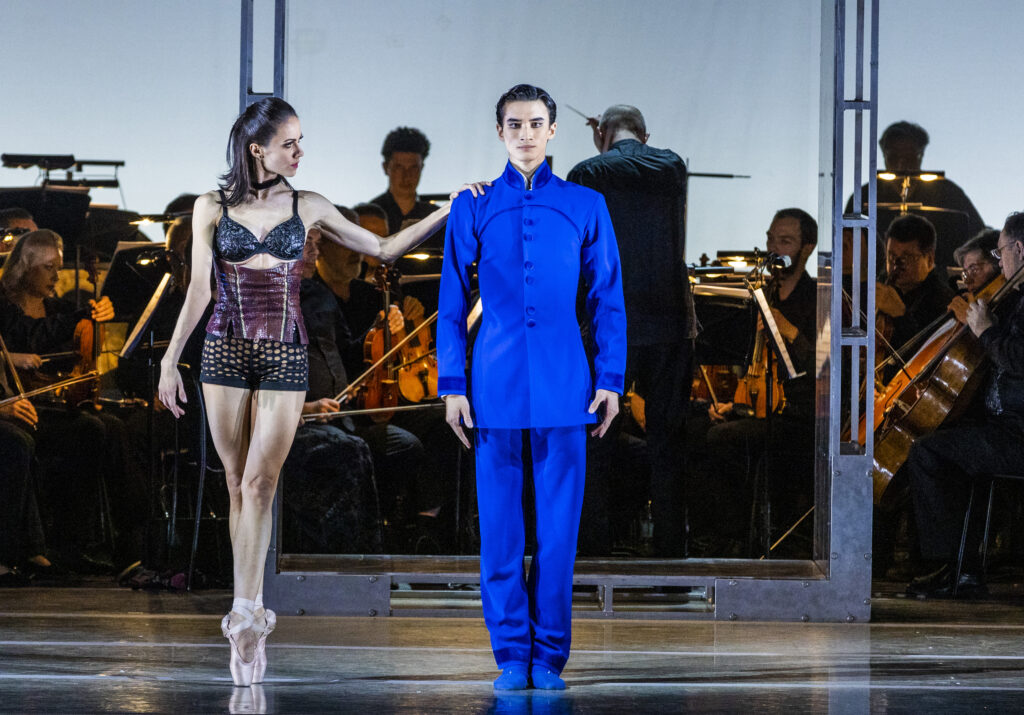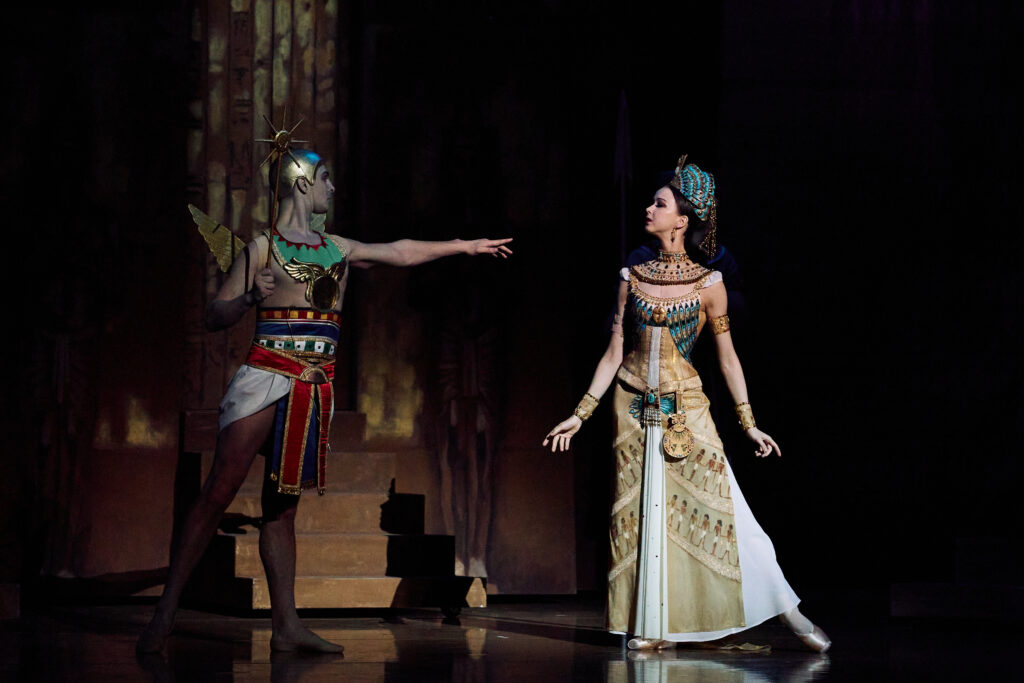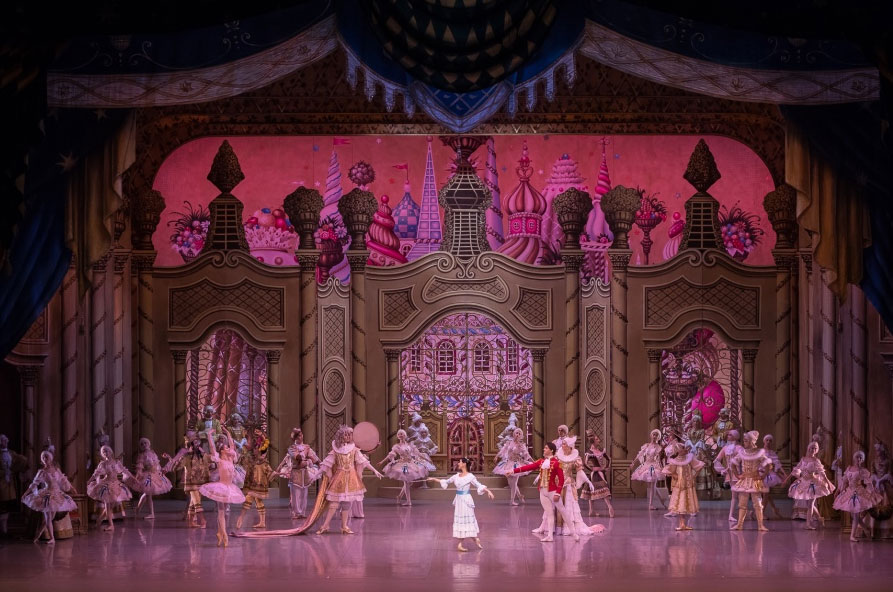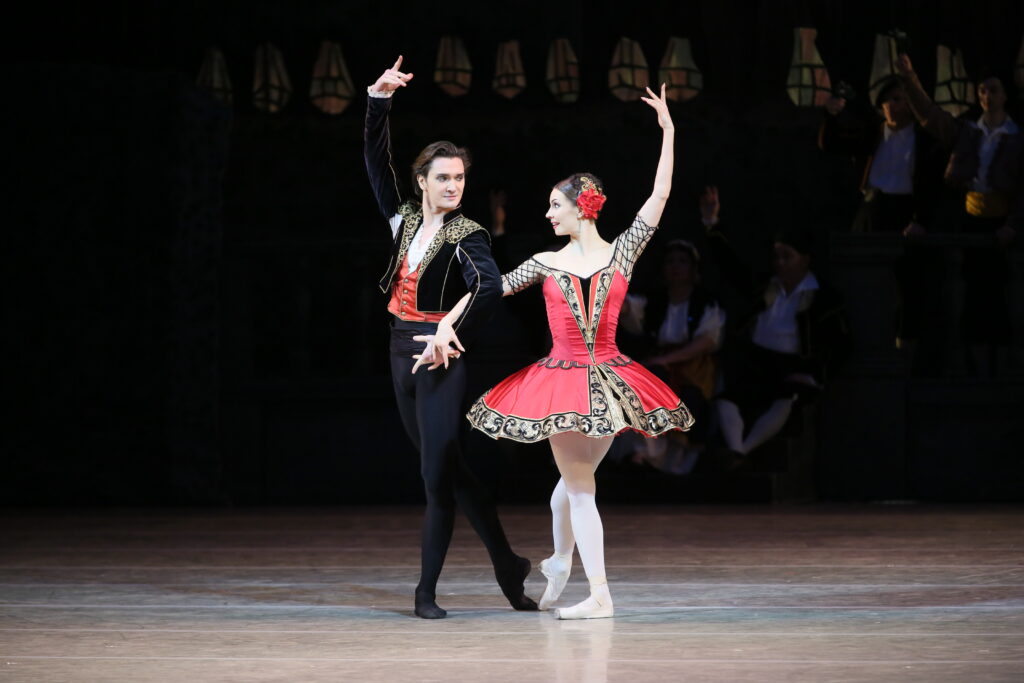 Leonid Jakobson’s version of “Spartacus” is a monumental, three-act stylistic ballet that immediately carries the viewer to ancient Greece through its unique choreographic style. Inspired, it is said, by the haut-reliefs of the Pergamon Altar, this “Spartacus” is littered with parallel (turned in) leg and arm positions intended to reproduce the two-dimensional images on Etruscan vases, scandalous positions in their heyday which veer far from the classical lexicon. There is not a pointe shoe in sight. Instead, it is as if an ancient Roman carving has come to life.
Leonid Jakobson’s version of “Spartacus” is a monumental, three-act stylistic ballet that immediately carries the viewer to ancient Greece through its unique choreographic style. Inspired, it is said, by the haut-reliefs of the Pergamon Altar, this “Spartacus” is littered with parallel (turned in) leg and arm positions intended to reproduce the two-dimensional images on Etruscan vases, scandalous positions in their heyday which veer far from the classical lexicon. There is not a pointe shoe in sight. Instead, it is as if an ancient Roman carving has come to life.
 Not everyone becomes a prince overnight, but Anton Osetrov might just be on his way. Now in his third season at the Mariinsky, the corps de ballet member recently assayed the role of Prince Siegfried in the White Swan Adagio as part of the “Theatrical Lesson” series for students from public schools citywide. In late March 2024, he debuted in the role of the Student in “Anuita”. VaganovaToday spoke to this young artist about his beginnings and aspirations. For the Russian version, click here.
Not everyone becomes a prince overnight, but Anton Osetrov might just be on his way. Now in his third season at the Mariinsky, the corps de ballet member recently assayed the role of Prince Siegfried in the White Swan Adagio as part of the “Theatrical Lesson” series for students from public schools citywide. In late March 2024, he debuted in the role of the Student in “Anuita”. VaganovaToday spoke to this young artist about his beginnings and aspirations. For the Russian version, click here.
Why did you start dancing?
I’ll start with the fact that I went into ballet myself, my family isn’t from the ballet world. My parents don’t like ballet. My mom loves opera and my father only likes dramatic theatre. They’re both artists though, my mother is an illustrator for books and my father restores historical paintings.
 More than 30 years ago, few foreign dancers, especially those from Europe, joined Russian (then “Soviet”) ballet companies. Yes, there was the rare Baryshnikov, who hailed from Riga, Latvia, but for the most part, Russian companies retained native Russian dancers or those from its provinces. Through a strange series of circumstances, Fethon Miozzi, who hails from Italy, completed his studies at the Vaganova Academy at a time when few foreigners did so. He then performed in Petersburg, and finally became a pedagogue at the Vaganova Academy where he has taught boy’s classes for the past 16 years. VaganovaToday sat down with him to trace his life story and hear about the transition from stage to teaching. To view the Russian version of this interview, please kick here.
More than 30 years ago, few foreign dancers, especially those from Europe, joined Russian (then “Soviet”) ballet companies. Yes, there was the rare Baryshnikov, who hailed from Riga, Latvia, but for the most part, Russian companies retained native Russian dancers or those from its provinces. Through a strange series of circumstances, Fethon Miozzi, who hails from Italy, completed his studies at the Vaganova Academy at a time when few foreigners did so. He then performed in Petersburg, and finally became a pedagogue at the Vaganova Academy where he has taught boy’s classes for the past 16 years. VaganovaToday sat down with him to trace his life story and hear about the transition from stage to teaching. To view the Russian version of this interview, please kick here.
 With over 20 years of stage experience, Mariinsky soloist Grigory Popov is still performing, but has recently added new forms of dance to his repertoire. The Mariinsky has recognized his skills in ultra contemporary movement and features him in a new educational program called “Theatrical Lesson” in which he performs his own choreography influenced by various modern masters. VaganovaToday sat down with him to discuss the trajectory of his career, this new direction, and what the future holds. Click here to read the Russian version of this interview.
With over 20 years of stage experience, Mariinsky soloist Grigory Popov is still performing, but has recently added new forms of dance to his repertoire. The Mariinsky has recognized his skills in ultra contemporary movement and features him in a new educational program called “Theatrical Lesson” in which he performs his own choreography influenced by various modern masters. VaganovaToday sat down with him to discuss the trajectory of his career, this new direction, and what the future holds. Click here to read the Russian version of this interview.
 Impeccable training in the city of Perm, clean lines, and loyalty to classical traditions won Ksenia Ostreikovskaya entry to the Mariinsky Ballet after her studies.
Impeccable training in the city of Perm, clean lines, and loyalty to classical traditions won Ksenia Ostreikovskaya entry to the Mariinsky Ballet after her studies.
As the first swan, and first Bayadère shade, to enter the sacred Mariinsky stage thousands of times during her 25 years dancing with the Mariinsky, Ostreikovskaya also performed numerous solo roles in an extensive repertoire of works ranging from Petipa to Balanchine to Hans Van Manen.
She recently retired from dancing and began coaching other dancers as a pedagogue. VaganovaToday joined her to discuss her stage years and her new role coaching others.
 Dear Readers,
Dear Readers,
Happy New Year! As 2024 begins, we look forward to more articles, reviews, premieres and general ballet news from Russia! VaganovaToday is starting a new article series this month called “Branching Out”, focused on Vaganova graduates who, reaching 20 or more years of dancing on stage, branch out in other directions, sometimes overlapping their stage time with new pursuits. These new directions may include pedagogy, choreography, modern dance, character roles, or even directing new productions. We hope you enjoy the new series. Please stay tuned for the best of Russian ballet, and greetings from the northern capital! – VaganovaToday
 Although the legendary Bolshoi Ballet star Vladimir Vasiliev first created his ballet “Anyuta” 37 years ago, its premiere at the Mariinsky on 08 December proved the work is as fresh and relevant today as it was then. The famous Chekhov tale is set to a memorable, addictive score by Valery Gavrilin that combines depth with musical themes that recur, underscoring the appearance of various characters. The libretto too speaks of eternal themes: the seduction of wealth and power often at the expense of family values and true love. This colossal staging effort featured three casts of performers, all of whom were honed by Vasiliev himself. The choreography, based on the version first created for television, is richer than most contemporary story ballets staged at major companies worldwide.
Although the legendary Bolshoi Ballet star Vladimir Vasiliev first created his ballet “Anyuta” 37 years ago, its premiere at the Mariinsky on 08 December proved the work is as fresh and relevant today as it was then. The famous Chekhov tale is set to a memorable, addictive score by Valery Gavrilin that combines depth with musical themes that recur, underscoring the appearance of various characters. The libretto too speaks of eternal themes: the seduction of wealth and power often at the expense of family values and true love. This colossal staging effort featured three casts of performers, all of whom were honed by Vasiliev himself. The choreography, based on the version first created for television, is richer than most contemporary story ballets staged at major companies worldwide.
 VaganovaToday had the honor of interviewing the legendary Vladimir Vasiliev, the Bolshoi Ballet star who later ran the Bolshoi Theatre for 5 years as its General Director, opened a school in Brazil, and continues to work as balletmaster, coach, and sculptor. Read below for the interview. Click here for the Russian version.
VaganovaToday had the honor of interviewing the legendary Vladimir Vasiliev, the Bolshoi Ballet star who later ran the Bolshoi Theatre for 5 years as its General Director, opened a school in Brazil, and continues to work as balletmaster, coach, and sculptor. Read below for the interview. Click here for the Russian version.
It is said that you started dancing in small children’s classes. Was your start in ballet your own desire, or the wish of your parents?
V. Vasiliev: It was probably providence, or my profession chose me. Because when I was 7 years old, I happened to end up in a dancing class when I went along with my friend “to keep him company” to the Kirov House of Pioneers in Moscow. They noticed me during the very first class, and the wonderful pedagogue Elena Romanova Rosse complimented me. She later advised my mother to send me to the Choreographic School since she thought I had talent.
You’re one of the greatest male dancers in the entire history of ballet. Which teachers helped you along the way, and what did each of them give you?
 The overarching themes of prostitution, theft, violence and murder form the backdrop to “The Miraculous Mandarin”, a 45-minute ballet whose title refers to the bright cobalt blue Mandarin-collar suit worn by the main hero. The production first greeted the Mariinsky stage in June 2023 after its initial premiere in Cleveland in 2017. VaganovaToday managed to attend the production in late November for the first time.
The overarching themes of prostitution, theft, violence and murder form the backdrop to “The Miraculous Mandarin”, a 45-minute ballet whose title refers to the bright cobalt blue Mandarin-collar suit worn by the main hero. The production first greeted the Mariinsky stage in June 2023 after its initial premiere in Cleveland in 2017. VaganovaToday managed to attend the production in late November for the first time. Winter came to Saint Petersburg early this year. For Americans, Thanksgiving weekend, celebrated during the third weekend in November, meant streets covered with snow and temperatures that dove to -10 Celcius. But inside the warm halls of the Mariinsky’s historical theatre building, a full house on Saturday night offered a Christmas-like atmosphere with a mixed bill featuring many terpsichorean treats.
Winter came to Saint Petersburg early this year. For Americans, Thanksgiving weekend, celebrated during the third weekend in November, meant streets covered with snow and temperatures that dove to -10 Celcius. But inside the warm halls of the Mariinsky’s historical theatre building, a full house on Saturday night offered a Christmas-like atmosphere with a mixed bill featuring many terpsichorean treats.
“Carmen Suite”, a specific type of ballet, is not everyone’s cup of tea. With three leading males, a corps de ballet of 8 more men, a trio of ladies, and the heroine, it contains a relatively minimal cast that nonetheless manages to pull the viewer into the world of Spanish bullfighting in less than an hour.
 In mid-July, as part of the “Context Diana Vishneva 2023” festival, prima ballerinas Diana Vishneva and Daria Pavlenko appeared together in the aptly named “Duo”, a production said to recall 19th century evenings of both opera and ballet. Yet “Duo”, performed on the stage of Saint Petersburg’s Bolshoi Dramatic Theatre, in fact included neither opera or ballet. The one-hour synthesis of music and dance presented, according to the program, “the ideal of duality and the variance of events”. Utterly modern choreography by Pavel Glukhov, based on “points of juxtaposition of the professional lives of the two ballerinas”, offered the two artists a chance to embody the synchronicities, unions, separations, impulses and reactions of the modern dance lexicon.
In mid-July, as part of the “Context Diana Vishneva 2023” festival, prima ballerinas Diana Vishneva and Daria Pavlenko appeared together in the aptly named “Duo”, a production said to recall 19th century evenings of both opera and ballet. Yet “Duo”, performed on the stage of Saint Petersburg’s Bolshoi Dramatic Theatre, in fact included neither opera or ballet. The one-hour synthesis of music and dance presented, according to the program, “the ideal of duality and the variance of events”. Utterly modern choreography by Pavel Glukhov, based on “points of juxtaposition of the professional lives of the two ballerinas”, offered the two artists a chance to embody the synchronicities, unions, separations, impulses and reactions of the modern dance lexicon.
 Maria Iliushkina’s humble, gracious manner and philosophical intelligence make this promising young ballerina stand out from her peers. After studying rhythmic gymnastics as a child, she shifted to ballet which held greater interest for her. Vaganova Today spoke with her about her career and life philosophy.
Maria Iliushkina’s humble, gracious manner and philosophical intelligence make this promising young ballerina stand out from her peers. After studying rhythmic gymnastics as a child, she shifted to ballet which held greater interest for her. Vaganova Today spoke with her about her career and life philosophy.
Your family isn’t associated with ballet: you initially studied rhythmic gymnastics and then shifted to ballet, why?
“Choreography” is in fact the term used for ballet lessons taken by gymnastics students. Rhythmic, or “artistic” gymnastics as it is called in Russia, is a school of movement that developed as a sport and is closely connected with ballet. It’s not rare for someone to shift from one world to another –sports to art– many ballerinas on stage here now came from gymnastics and started as athletes. Gymnastics is great for the development of “plastique” (physical expression and flexibility), coordination, endurance, and musicality. It turned out that I enjoyed my choreographic lessons (ballet lessons) much more than the gymnastics. The pedagogue at our gymnastics school was a former ballerina who told me I had the right traitsfor ballet, even more so than for gymnastics. So I attended the Academy of Vaganova. There was a sense of purpose associated with it.
 Petipa’s creations, in their essence, are unmistakable: lines of corps de ballet in various formations, a love triangle culminating in the victory of love over evil, power or convention, layers of demi-soloist variations punctuating the leading characters’ solo dancing, elaborate set changes and exquisite costumes. Petipa’s large, three- (or originally four-) act masterpieces were intended as half-day entertainment for the nobility, and considering their length, were tall orders to fulfill. As a result, some of them included a large range of –at times arguably superfluous– additions, including storms, live animals, lovely maidens, and types of stage contraptions that ascend, descend or slide across stage. Above all though, they contain fairytales. Such is the case with the reconstruction of “The Pharoah’s Daughter”, a Petipa ballet first created 161 years ago at the Mariinsky’s historical theatre that reappeared this year on March 24 after more than 5 years of research restorative efforts.
Petipa’s creations, in their essence, are unmistakable: lines of corps de ballet in various formations, a love triangle culminating in the victory of love over evil, power or convention, layers of demi-soloist variations punctuating the leading characters’ solo dancing, elaborate set changes and exquisite costumes. Petipa’s large, three- (or originally four-) act masterpieces were intended as half-day entertainment for the nobility, and considering their length, were tall orders to fulfill. As a result, some of them included a large range of –at times arguably superfluous– additions, including storms, live animals, lovely maidens, and types of stage contraptions that ascend, descend or slide across stage. Above all though, they contain fairytales. Such is the case with the reconstruction of “The Pharoah’s Daughter”, a Petipa ballet first created 161 years ago at the Mariinsky’s historical theatre that reappeared this year on March 24 after more than 5 years of research restorative efforts.
 Any modern day choreographer who attempts to reset a classical ballet using his own steps is to be lauded for the task is daunting in the face of masters such as Petipa (“Swan Lake”) or, in the case of Russia’s most widely known version of “The Nutcracker”, its original choreographer, Vasily Vainonen.
Any modern day choreographer who attempts to reset a classical ballet using his own steps is to be lauded for the task is daunting in the face of masters such as Petipa (“Swan Lake”) or, in the case of Russia’s most widely known version of “The Nutcracker”, its original choreographer, Vasily Vainonen.Yago Gonzaga received his early ballet training in Brazil, performed with the Perm Ballet Theatre in Russia, and after being spotted by Laurent Hilaire, more recently became a soloist in Munich’s Bayerishe Staatsballett. His incredible lines, elastic flexibility and innate musicality mixed with a deep sense of romanticism make him not just a talented dancer, but one who clearly will become a principal with the troupe before long. VaganovaToday spoke with him about his career path to date.
 The majority of ballet films, while showing the rigor, discipline, and endless stamina required for the profession, nevertheless have a tendency to exaggerate certain aspects of the art. The “glass in pointe shoes” theme from the movie “Black Swan”, and the starstruck relentless stage mother in “The Turning Pointe” are two that give ballet a bad name, or at least embellish the negative, establishing connotations that are not constants in every ballet company or for every dancer. Some films include poor acting, bad camera angles, and campy scenes meant only for mass consumption, and few are the films on ballet that truly capture the internal life of ballet dancers.
The majority of ballet films, while showing the rigor, discipline, and endless stamina required for the profession, nevertheless have a tendency to exaggerate certain aspects of the art. The “glass in pointe shoes” theme from the movie “Black Swan”, and the starstruck relentless stage mother in “The Turning Pointe” are two that give ballet a bad name, or at least embellish the negative, establishing connotations that are not constants in every ballet company or for every dancer. Some films include poor acting, bad camera angles, and campy scenes meant only for mass consumption, and few are the films on ballet that truly capture the internal life of ballet dancers.
All photos courtesy of Mariinsky Theatre, by photographer Alexander Neff.
Over the past 300 years, there has not been a single war during which Russian ballet stopped its activity.
Just after the Great Russian Revolution of 1917, Agrippina Vaganova helped save the Imperial Ballet from dying at the hands of the new Soviet regime by creating a new methodology within the Leningrad Choreographic School, and “updating” classical ballets such as Swan Lake and Esmeralda, in order to make them easily digestible by the proletariat. During World War II, ballet students evacuated far from the front lines to the city of Perm, where they continued to study and train, planting the seeds for the preservation of Vaganova’s methodology in the theatre there.
 January 2022 brought some new promotions at the Bolshoi.
January 2022 brought some new promotions at the Bolshoi.
Jacopo Tissi, who hails from Italy, was promoted to principal dancer by Makhar Vasiev after just 5 years with the troupe.
Igor Tsvirko likewise was made principal dancer.
Congratulations to both on their new ranks! And Happy New Year! Vaganova Today is looking forward to what 2022 has in store for all of the ballet companies of the world. Here is to more performances and more promotions!
Perhaps one of the most intellectual choreographers on the ballet landscape today, Maxim Petrov gained his roots in choreography even as a student of the famed pedagogue Gennady Seliutsky, and continued to grow his career creating ballets while simultaneously performing with the Mariinsky. This young man is already the holder of Russia’s prestigious Golden Sofit and Golden Mask awards, and has already expanded his horizons and set ballets in the US. Click to hear more (English subtitles are provided).
If you enjoy these videos, please consider supporting our site so that we can provide more content to you! Click the “Become a patron” button. Even a $5 donation can help us cover production costs. Thank you and happy holidays!
 Starting on the 4th of December, Vaganova Academy students performed three Nutcracker performances prior to the end of 2021 in which, per the usual tradition, former graduates danced Clara and the Prince with students dancing all of the other roles.
Starting on the 4th of December, Vaganova Academy students performed three Nutcracker performances prior to the end of 2021 in which, per the usual tradition, former graduates danced Clara and the Prince with students dancing all of the other roles.
The Academy has been plagued with the pauses and restrictions that come with the Covid pandemic– instead of graduation performances on stage the Mariinsky, last year the performance was held inside the Academy’s small theatre. More recently, restrictions have lifted slightly, and in addition to performing in their own “Nutcracker”, the students have also participated in the Mariinsky’s “Sleeping Beauty” and “Shurale” within the span of the same month.
At the general rehearsal of this Vainonen “Nutcracker” –performed to a full orchestra with costumes– Maria Koshkaryova, who will graduate in 2022, danced the first adult Clara. Koshkaryova is a slight, petite brunette, with long slender limbs and a youthful appearance. She shows much technical promise. For the first performance however, Anastasia Lukina, already with the Mariinsky since 2015, danced “big” Clara with professional polish and noble presentation. If not emitting the youthful freshness and raw sparkle of a student, her refinement and are evident throughout. Lukina has gained greater control of overly flexible feet and limbs over the last five years in the troupe, giving her great command of the stage, in addition to her natural beauty.

